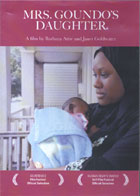
Mrs. Goundo’s Daughter 2009
Distributed by Women Make Movies, 462 Broadway, New York, NY 10013; 212-925-0606
Produced by Barbara Attie and Janet Goldwater
Directed by Barbara Attie and Janet Goldwater
DVD, color, 60 min.
Sr. High - Adult
African Studies, Anthropology, Sociology, Women's Studies
Date Entered: 11/18/2009
Reviewed by Sandy River, Architecture and Humanities Librarian, Texas Tech UniversityMrs. Goundo is seeking asylum in the United States. While she sometimes wishes she could go back to her native Mali, she cannot bear to leave her toddler daughter and is afraid to take her there because she is certain the child will be subjected to female genital cutting. At film’s end, after the federal government has failed to follow-through on an appeal of the judge’s asylum order, it appears that Mrs. Goundo will be given a green card. This is the unifying story of this film, but a number of themes are touched, making this a useful video for many disciplines.
The story moves between Philadelphia, where Mrs. Goundo lives with her undocumented husband and their three children, and Mali, where 85% of women and girls are subjected to cutting, or excision as it is called there. The grayness of Mrs. Goundo’s Philadelphia neighborhood contrasts starkly with the vibrancy of Mali. It is obviously a poor country, but laughter and colorful clothing explain Mrs. Goundo’s claim that there was always fun when she was home. But some of the Mali footage is taken on an excision ceremony day; we see the preparation of the “medicines” beforehand and see the little girls after – some crying and some walking slowing because of the pain.
The film doesn’t argue a case against genital cutting. Women who have undergone the procedure speak for and against it. Religious leaders disagree on whether Islam calls for the procedure. A woman who performs excisions speaks as do health activists who are trying to end this tradition. The film is an exploration of how a traditional practice is sustained and how it can be changed. Additionally, it provides an example of societal imbalances between men and women in a traditional culture. And it demonstrates some of the difficulties that immigrants to the U.S. face, especially those who lack proper documentation. The asylum application process seems daunting enough; imagine facing it without English language skills.
The video work on the film is very good. You get a strong sense of place both in Philadelphia and Mali. The colors alone in Mali hold your attention. The sound work is also good, considering that much of the filming was done outdoors. Many of the people interviewed speak in French or Bambara; English subtitles are provided. Periodically, statistics about the prevalence of female genital cutting appear on screen.
The film would be particularly useful in classes studying traditional African cultures and the treatment of women in those cultures.